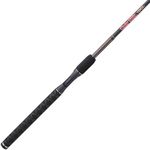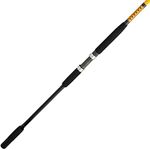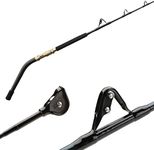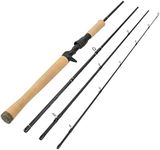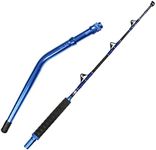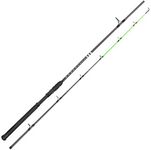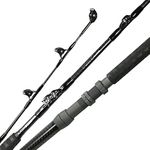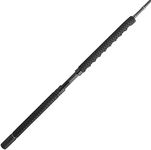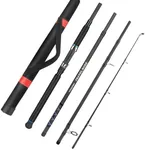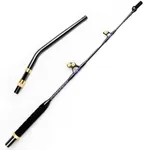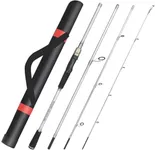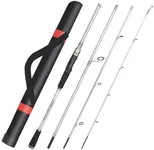Buying Guide for the Best Trolling Rods
Choosing the right trolling rod is essential for a successful and enjoyable fishing experience. Trolling rods are specifically designed for trolling, a method of fishing where lines with baited hooks are drawn through the water. The right rod will depend on the type of fish you're targeting, the environment you'll be fishing in, and your personal preferences. Here are some key specifications to consider when selecting a trolling rod.Rod LengthRod length is the measurement from the tip of the rod to the butt. It is important because it affects casting distance, leverage, and control. Shorter rods (6-8 feet) offer better control and are ideal for trolling in smaller boats or when targeting larger fish. Medium-length rods (8-10 feet) provide a balance between control and casting distance, making them versatile for various fishing conditions. Longer rods (10-12 feet) are great for covering more water and are often used in open water or when targeting smaller fish. Choose a length based on your fishing environment and the type of fish you aim to catch.
PowerPower refers to the rod's ability to withstand pressure and is often categorized as light, medium, or heavy. This spec is crucial because it determines the size and weight of the fish you can handle. Light power rods are suitable for small fish and light lures, medium power rods are versatile and can handle a variety of fish sizes, and heavy power rods are designed for large, powerful fish. Select the power based on the species you are targeting and the type of lures you plan to use.
ActionAction describes how much and where the rod bends when pressure is applied. It is important because it affects the rod's sensitivity and hook-setting ability. Fast action rods bend mostly at the tip and are very sensitive, making them ideal for quick hook sets and detecting subtle bites. Medium action rods bend more towards the middle, offering a balance of sensitivity and strength, suitable for a variety of fishing techniques. Slow action rods bend throughout the entire length, providing a more forgiving and flexible experience, which is great for fighting larger fish. Choose the action based on your fishing style and the type of fish you are targeting.
MaterialThe material of the rod affects its weight, sensitivity, and durability. Common materials include fiberglass, graphite, and composite. Fiberglass rods are durable and flexible, making them ideal for beginners and for trolling in rough conditions. Graphite rods are lighter and more sensitive, providing better performance and feel, but they can be more fragile. Composite rods combine the benefits of both materials, offering a balance of strength, sensitivity, and durability. Consider the material based on your experience level and the fishing conditions you expect to encounter.
Line WeightLine weight indicates the range of line strengths that the rod is designed to handle. This spec is important because using the correct line weight ensures optimal performance and prevents damage to the rod. Light line weights (2-10 lbs) are suitable for small fish and light lures, medium line weights (10-20 lbs) are versatile for various fish sizes, and heavy line weights (20+ lbs) are designed for large, powerful fish. Choose the line weight based on the species you are targeting and the fishing conditions.
GuidesGuides are the rings along the rod that direct the fishing line. They are important because they affect casting distance, accuracy, and line management. More guides generally provide better line control and smoother casting. High-quality guides made from materials like ceramic or stainless steel reduce friction and increase durability. Consider the number and quality of guides based on your fishing style and the type of line you plan to use.
